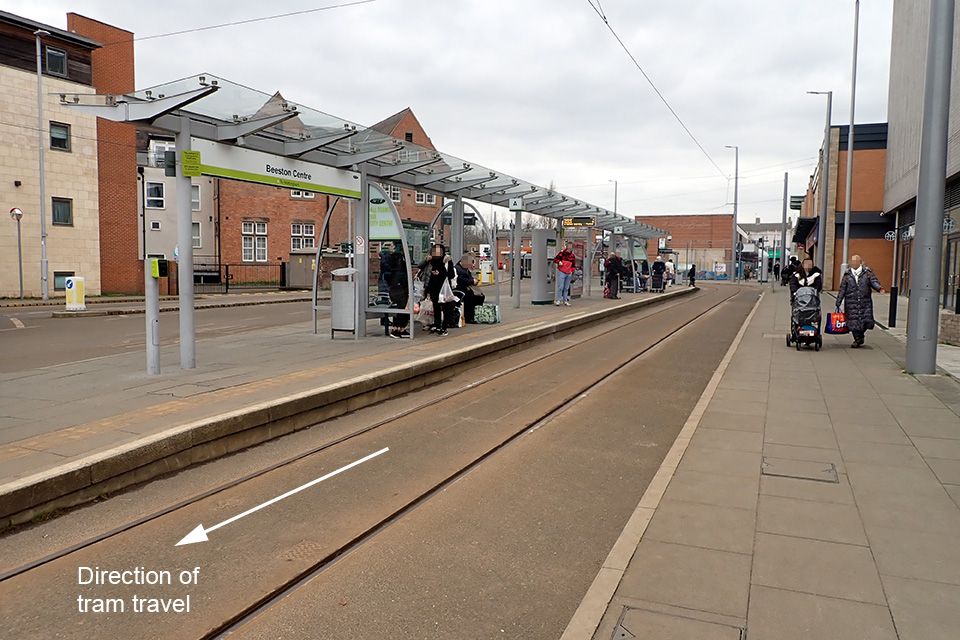Trap and Drag Passenger Incident, Departing Tram, Nottingham

At around 11:04 pm, Wednesday, February 22, 2023, authorities found a passenger dragged alongside a departing tram at Beeston Centre tram stop, on the Nottingham tram network, as RAIB (Rail Accident Investigation Branch) reports.
Shortly before the Nottingham tram departed, the passenger had placed a hand and a walking stick into the closing doors of the tram, in an unsuccessful attempt to prevent them from closing. Once the doors closed, the walking stick became trapped. The driver was unaware that the stick was trapped and started the tram. The passenger held onto their walking stick as the tram departed and was pulled alongside the tram for around three seconds, before falling against the tram and landing on the edge of the tram stop. This resulted in serious injuries to the passenger.
The Nottingham accident occurred because the tram driver was not aware that the walking stick was trapped in the doors, and that the passenger was holding on to the stick, when the driver made the decision that it was safe to start the tram.
Tram stop CCTV footage shows that the tram arrived at Beeston Centre tram stop and its doors became fully open at 18:04:09 hrs. This footage also shows that the doors started to close again at 18:04:19 hrs, meaning that they were fully open for about 10 seconds. The passenger involved in the accident had waited to cross the tramway behind the arriving tram before walking up to the tram stop and activating a travel card. CCTV shows that, by the time the passenger attempted to board at the rearmost doors, the tram’s doors were already starting to close. Closing tram doors are accompanied by an audible warning.
The tramway operator Nottingham Trams Limited (NTL, who trade as Nottingham Express Transit) stated that it trains drivers to allow a dwell time of around 15 to 20 seconds at tram stops.
The tram’s doors were fully closed by 18:04:21 hrs and the tram started to move three seconds later, at 18:04:24 hrs. The walking stick was not detected by the tram’s door obstacle detection system once the doors had closed. This system works by sensing an increased electric current being drawn by the tram’s door motors and is designed to detect obstructions greater than 30 mm wide. If no obstacles are detected, the closed doors will lock and an electrical interlock circuit will be completed which permits the driver to take traction power to move the tram. The driver will also receive audible and visual indications that the doors have closed and locked.
After the accident, NTL tested the tram’s doors and found that they met the relevant detection requirement. The walking stick was not recovered by RAIB and its diameter remains unknown. However, a survey of the type of walking stick apparently used, showed that they typically have a diameter of less than 1 inch (25.4 mm) and so are unlikely to trigger the tram’s door obstacle detection system.
Before commanding the doors to close, NTL’s driving policy requires tram drivers to use their in-cab CCTV screens to check that the doors are clear. The policy advises them that ‘it is important to keep a good lookout for vulnerable passengers that may become separated or articles protruding through the doors’. Once the doors are closed and locked, drivers are required to carry out a final visual check using the CCTV screens, to ensure it is safe to depart.
This accident demonstrates the importance of:
- tram drivers completing an effective final visual safety check, using CCTV and other equipment to the best possible extent, to ensure it is safe to depart from a tram stop;
- tram drivers not relying on door closed indications as confirmation that it is safe to move a tram – obstacle detection systems are not always capable of detecting objects trapped in a closed and locked door;
- tram operating companies effectively monitoring compliance with operating rules.
Source/credit for content/image: RAIB, “Passenger dragged at Beeston Centre tram stop, Nottingham, 22 February 2023,” published 4/2023.



